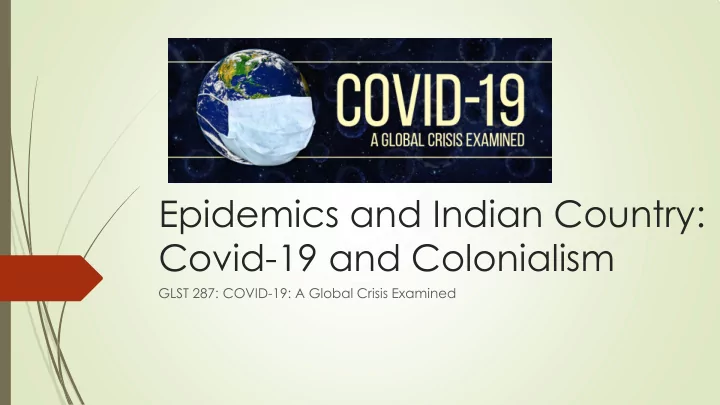

Epidemics and Indian Country: Covid-19 and Colonialism GLST 287: COVID-19: A Global Crisis Examined
“While the State and county have moved into phases of reopening, the reservation remains closed to all visitors until further notice. Please anticipate the reservation being closed through the remainder of the year, with a reopening not planned at this time.”
Why? Epidemiology History Spiritually Ethics Image by George Curtis Levi (Southern Cheyenne/Arapaho)
Epidemiology: Social Determinants of Health Image: Portland Area Indian Health Board
Epidemiology: Social Determinants of Health Poverty $57,600> $39,700 Less clean water, sanitation, wifi and cell service Image: Portland Area Indian Health Board
Epidemiology: Social Determinants of Health Poverty $57,600> $39,700 Less clean water, sanitation Twice as likely to not have insurance Image: Portland Area Indian Health Board
Epidemiology: Social Determinants of Health Poverty $57,600> $39,700 Less clean water, sanitation Twice as likely to not have insurance Preexisting Conditions TB (6x) Diabetes (2.5x) Obesity Kidney, Liver, & Heart Disease Image: Portland Area Indian Health Board
Epidemiology: Social Determinants of Health Poverty $57,600> $39,700 Less clean water, sanitation Twice as likely to not have insurance Underlying Conditions TB (6x) Diabetes Obesity Kidney, Liver, & Heart Disease Multigenerational households Image: Portland Area Indian Health Board
Infection Rates Nationally: deaths per 100,000 Indigenous: 81.9 White: 46.6 Washington: Indigenous: 63.9 White: 23.8 Alaska: Native Alaskan: 14.4 White: 3.8 South Dakota: Indigenous: 56.1 White: 15.9
Infection Rates Nationally: deaths per 100,000 Indigenous: 81.9 White: 46.6 Minnesota: Indigenous: 57.4 White: 32.2
Infection Rates Nationally: deaths per 100,000 Indigenous: 81.9 White: 46.6 Minnesota: Indigenous: 57.4 White: 32.2 Arizona: Indigenous: 203 White: 57.2 New Mexico: Indigenous: 231.6 White: 25.6
Infection Rates Nationally: deaths per 100,000 (Adjusted for Age) Indigenous: 81.9 124.7 White: 46.6 38.4 South Dakota: Indigenous: 56.1 136.6 White: 15.9 13.4 Arizona: Indigenous: 203 334.9 White: 57.2 25.3 New Mexico: Indigenous: 231.6 340 White: 25.6 16.2
Highest Infection Rates Navajo • Mississippi Band of • Choctaw White Mountain Apache • Pueblo of Zia • Pueblo of San Felipe • Kewa Pueblo • Winnebego Tribe of • Nebraska Colorado River Indian Tribe • Yakama • Shaandiin Parrish, Miss Navajo Nation, distributing masks and hand sanitizer at a checkpoint in Chinle, AZ. (New York Times)
Highest Infection Rates “We aren’t losing family • members or an aunt or uncle, we are losing parts of our culture. We’ve lost dressmakers, we’ve lost artists, elders who were very fluid in our language—so when you think about an individual we’ve lost, these are important people in our community.” -Mary Harrison, Health • Mississippi Choctaw drive-through testing site. (New York Times) Director, Choctaw Health Center
Historical Context
Historical Context Epidemics Suppression of Traditional Healing Practices Historical Access to Care Ethical Abuses Within Medical System
Historical Context Epidemic diseases: Smallpox Plague Cholera Influenza Malaria Diphtheria Tuberculosis Syphilis Gonorrhea
Lord Amherst, 1763
Duncan McDougal, Ft. Astor “The white men among you are few in number, it is true, but we are mighty in medicine.” He held up a vial for all to see. “In this bottle I hold smallpox all corked up; I have but to draw the cork to let loose the pestilence and sweep man, woman, and child from the face of the earth.”
Historical Access to Care Reservations 1934: “Indian New Deal” 1955: Indian Health Service 1968: Community Health Representative Program 1976 American Indian Self Determination and Education Assistance Act Puyallup Tribal Health Authority (https://www.eptha.com/)
Religious and Ethical Contexts
Religious and Ethical Context Relational Responsibility Multigenerational Perspective Care for Elders
Relational Responsibility Healthy Self Relational Natural World Holy People Ancestors Human Community
Relational Responsibility Healthy Self Relational Natural World Holy People Ancestors Human Community “The basic problem is that American society is a ‘rights society’ not a ‘responsibilities’ society.” –Vine Deloria, Jr.
Multi- Generational Perspective Seven Generations Ancestors Future Generations
Care for Elders Vernon Blackeyes (Pine Ridge Lakota), Sarah Anderson (Omaha) and their daughter share supplies with elders on March 15, 2020, when supplies were first running low.
Care for Elders An aging body, alongside a life well lived, is testament to “the maturation of knowledge and power that these bodies carry, not to mention the authority of experience accrued, tried, tested, and tempered over time… Old age itself marks a kind of religious attainment, and eldership carries a corresponding religious prestige and authority by virtue of the mastery of relatedness.” Vernon Blackeyes (Pine Ridge Lakota), Sarah Anderson (Omaha) and their daughter share supplies with elders on March 15, 2020, when supplies were first running low.
Care for Elders Elders “pass on power and knowledge toward life to younger generations, in return for respect.” And respect is the “paradigmatic ethical relation that grounds all other relations in the social, natural, and spiritual realms.”
Care for Elders If Native people “do succeed in distinctly honoring elders, it is emphatically not because they naturally do so. Instead, honoring elders has required hard work, the disciplined labor of moral teaching and the ritualized decorum that constitute the authority of elders through practices of deference.”
History. Relationality. Responsibility. Elders.
Recommend
More recommend